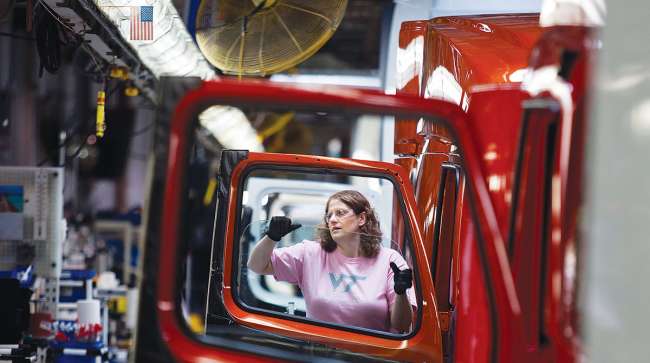Senior Reporter
June Class 8 Sales Highest of the Year

[Stay on top of transportation news: Get TTNews in your inbox.]
U.S. Class 8 retail sales in June were the highest of the year and improved 12.7% compared with the previous June, Wards Intelligence reported.
Another analyst said production levels, according to truck makers’ plans, are set to accelerate in the second half, indicating sufficient available parts are less of an issue than they have been.
Sales reached 22,358 compared with 19,840 a year earlier — which also was the second-highest volume in the last 18 months.
Preliminary NA Class 8 net orders in June were 15,500 units, while NA Classes 5-7 net orders were 17,800 units. Complete industry data for June, including final order numbers, will be published by ACT Research in mid-July.https://t.co/ANnlKj9kOH#truck #semitruck #Class8 pic.twitter.com/JYuCo18fz1
— ACT Research (@actresearch) July 6, 2022
Year-to-date, sales rose 0.6% to 112,255 compared with 111,552 in the 2021 period.
“It seems like we have gotten caught up on some of these partially built trucks,” said Steve Tam, vice president at ACT Research.
In the United States, Class 8 production is expected to increase by 5,000 to 130,000 in the second half compared with 125,000 in the first half, he said.
That accelerating production would come as the economy, “from a price perspective, is inflated, on fire,” Tam said. “And at the same time, economic growth is kind of stalling out.”
But pent-up demand for new trucks remains, giving the Class 8 sales market its own discrete rhythm. “That’s what’s interesting,” he said. “The truckers are flush with cash. They are going to invest in equipment and buy the trucks they have on order.”
Jenny Vander Zanden, chief operating officer at Breakthrough, which provides transportation technology and market insights, said, “There is some matching of the [sales and freight] cycles that can be a little challenging. What is a carrier’s ability to purchase that new truck?”
New Class 8 trucks are capable of 8 miles per gallon or more, amid historically high diesel prices, depending on their configuration and technologies. “The truck makers’ success has certainly lent itself to industry needs and the shifting dynamics of efficiency,” she added.
“Overall June’s volume is a good sign,” said Charles Roth, commercial vehicles analyst at FTR.
He noted it also likely means dealer inventories improved and buyers are snapping that up. “If demand is strong there, it’s a sign small and medium-sized carriers are still willing to purchase equipment.”
He added higher truck prices are not impeding sales, and larger fleets’ purchase plans for 2022 are on track and they are continuing to take on new equipment, too.
Four truck makers improved sales in June and three did not compared with a year earlier.
The biggest jump was at Volvo Trucks North America. Sales soared 82% to 2,679 units, good for a 12% market share, a 2% year-over-year improvement.

Koeck
“We are taking market share in a good way, working to complete a good value chain,” Roger Alm, president of Volvo Trucks, said about the North American market during a capital markets day presentation in June.
VTNA is a unit of Volvo Group.
VTNA’s Magnus Koeck, vice president of strategy, expects a normally slower market in July and the beginning of August before sales pick up again. “Even if we see a slight improvement in the supply chain, we anticipate that continued labor and material shortages will impact the deliveries throughout the next quarter.”
Peterbilt Motors Co. sales climbed 19.9% to 3,418, good for a 15.3% share.
Kenworth Truck Co. sales rose 16.4% to 3,194 and a 14.3% share.
Peterbilt and Kenworth are brands of Paccar Inc.
Market leader Freightliner, a brand of Daimler Truck North America, increased sales 9.5% to 8,129, good for a 36.4% share.
Daimler’s sales, in the years ahead, like those by other truck makers, will increasingly be keyed to an array of new technologies.
“We are significantly reducing our diesel-related investments,” Martin Daum, chairman of Daimler Truck, said during the company’s recent general meeting.
Daimler aims from 2039 on to only sell vehicles in North America, Europe and Japan “that are emission-free in operation,” Daum said. “By 2030 zero-emission vehicles should account for up to 60% of our global sales.”
Daimler is planning a joint venture with NextEra Energy Resources and BlackRock Renewable Power that would create a nationwide infrastructure in the U.S. for both battery-electric and hydrogen-powered vehicles.
Autonomous trucks are another key emphasis, he said. “Specifically, we have the goal of starting series production of autonomous trucks for long-distance transport before the end of this decade. As a first step, they are planned to run on American highways between large logistics centers.”
Those that did not gain sales in June compared with a year earlier were:
- Western Star, which watched sales fall 25% to 451 and a 2% share. Western Star is a brand of DTNA.
- Mack Trucks, which saw sales fall 8.5% to 1,560, good for a 7% share — higher than its 6.5% year-to-date share.
“Our share gain is a result of our consistent focus on improving flow through to the sales pipeline,” said Jonathan Randall, senior vice president of sales at Mack, a unit of Volvo Group.
- International, which saw sales fall 3.8% to 2,927 for a 13.1% share. International is a brand of Navistar Inc.
Want more news? Listen to today's daily briefing below or go here for more info:

